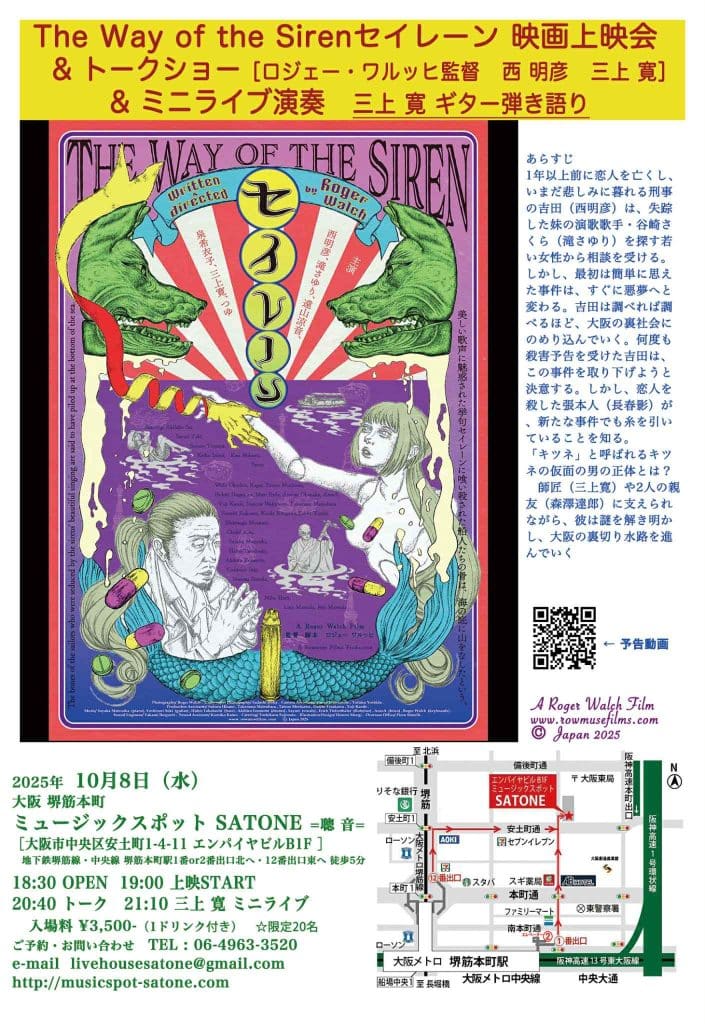2025: Kansai-based Swiss film director Roger Walch is back with a new Osaka feature, the action all taking place in the southern part of the city, in Shin Sekai, Nishinari-ku and Dotonbori.

The movie starts out like a classic film noir from the 1940s: former mercenary and now private detective Masahiko Yoshida, usually called Masa (Akihiko Sai) has been out of work for a while, memories of his ex-girlfriend Megumi (Keiko Izumi) plague him, he hits the whisky bottle heavily.
Severely hungover, one morning he hears a knock on his door. A potential client with a special request: a woman (Suzune Toyama), dressed gothic-style and walking with a crutch asking him to search for her younger sister, enka singer Sakura Tanizaki (Sayuri Taki). Masa is not interested but when the strange woman hands him an envelope with a large sum, he reluctantly agrees to take on the case.

He inspects the living quarters where the mysterious gothic woman lived with her sister… and yes, the many strange dolls on display in her room are really the creations of Suzune Toyama, the actress playing the gothic woman. She’s a famous Osaka doll maker with her very own and quite bizarre doll-making style.

The gothic woman then takes Masa to the venue where Sakura Tanizaki’s last concert took place in the night of her appearance. It’s daytime and the club is empty… but we are treated to a flashback of her last performance. Actress Sayuri Taki playing Sakura Tanizaki is a real enka singer after all and we get to see her performing her song Hana oshimi zuki (花惜月) in full length. The song will make repeated appearances throughout the movie.
With a photo of Sakura Tanizaki in hand Masa then heads to the dive bars and jazz joints of Nishinari…
Audiences elsewhere may take all that as just some exotic flavoring of a rather straight detective story but Osaka audiences in the know understand that Walch’s film is nothing less than a great celebration of the subterranean arts scene of the city.
The bar owners Masa questions in his search are the real proprietors of the bars, and so is the ramen shop guy who gives Masa a crucial tip: “See that gaijin across the street? That’s Mickey, the dealer. Follow him and you will find some answers.”
Mickey the dealer is played by none other than Osaka.com’s frequent contributor Matt Kaufman (credited as Matt Exile in the movie), a Brighton Beach, Brooklyn native and Osaka resident since the 1990s.
Masa does as he is told but in the dark confines of the Shin Sekai Toei movie theater, Mickey eventually manages to evade him.

Instead, Masa is confronted by theater manager Hideki Nagamine (playing himself in his real theater) who tells him back in the projection booth that all of the area is under the control of Mr. Kosaka’s Fox Gang. While doing so, Nagamine rewinds the 35mm print of an old Toei movie. He runs a real movie theater, still screening films from celluloid.
The Fox Gang. Masa knows that that is same gang that had killed Megumi, the girlfriend he misses so much.
Masa turns to seeking advice from his old mentor, played by folk singer Kan Mikami. The advice he receives is to simply give up in his search for the missing girl. Though the mentor dresses that message up in more mysterious, more philosophical wording.
Soon, Masa realizes that he himself is becoming a target of the Fox Gang… the most powerful yakuza gang in an area where even little children draw fox heads on the pavement and give Masa fox salutes.
Masa is not out to revenge his killed girlfriend… and a new girl is already making serious advances towards him… why bother about that missing enka singer? That was a job. He failed to solve the case.
But then, in the last 15 minutes of the film, things totally turn around. Only then, the title The Way of the Siren unfolds it real meaning…
Table of Contents
The Way of the Siren (Japan, 2025) セイレーン
As a sign of the times, Walch starts – pre-credits – with the statement that no AI and no computer graphics were used in the film. In the end credits we learn that (almost) all photography was done by Mr. Walch himself. Pure, old-fashioned craftmanship.
As his previous Osaka tales, like, say, Der Deutsche / The German (2018), The Way of the Siren closely straddles the line between crime drama, art film and documentary of the local arts scene.
All artists depicted in the film perform or display their own works. The ones not assigned major acting roles simply play themselves.
Actor Akihiko Sai

Akihiko Sai is the actor playing detective Masahiko Yoshida. He is present in virtually every minute of the movie.
Akihiko Sai (real name Akihiko Nishimura), was born in 1975 and he has a strong background in martial arts. According to imdb.com, Sai has studied various Chinese martial arts for 25 years, he has skills in the handling of swords, spears, sticks, knives and whips and he received training in tactical shooting by both the Indian Army and the U.S. Marine Corps.
Sai has extensively worked as action movie actor / stunt man since his start in the genre in the 2003 American production The Last Samurai starring Tom Cruise and Ken Watanabe.
Other titles include the 2004 Hong Kong production Silver Hawk (starring Michelle Yeoh), the Jackie Chan movie Shinjuku Incident (2009) and the 2021 yakuza thriller Kate, starring Woody Harrelson.
The Way of the Siren was not Akihiko Sai’s first work with Roger Walch. Sai already played the missing father in Walch’s 2022 film Anaïs. Searched and eventually found by his 14 year old French daughter Anaïs on subtropical Amami Island, south of Kagoshima, almost halfway to Okinawa.
Anaïs was Sai’s first character actor role. In The Way of the Siren, however, Walch gives Sai the opportunity to show his full acting abilities. Sai is very convincing in his role as melancholy, hard-drinking detective … and he has some good fight scenes, too. Choreographed by Sai himself.

Actor Kan Mikami

Besides Akihiko Sai, the other accomplished actor in The Way of the Siren is Kan Mikami. Most Japanese know Mikami as a folk singer who had his greatest success in the 1970s.
However, Mikami has quite an impressive resume in the film world as well. For example, he acted in Pastoral: To Die in the Country (1974) by legendary avant-garde theater leader Shuji Terayama and he was quite active in Terayama’s Red Tent theater group as well.
Mikami can also be seen in Kinji Fukasaku’s New Battles Without Honor and Humanity: Last Days of the Boss (1976) and in Merry Christmas, Mr. Lawrence (1983) by Nagisa Oshima, starring David Bowie, Ryuichi Sakamoto and Takeshi Kitano.
Last but not least, Kan Mikami was the instigator of and main actor in Roger Walch’s own Der Deutsche / The German, a movie taking entirely place in the homeless area of Kamagasaki, Nishinari-ku, Osaka (2018).
The Artists
Thankfully, the press package Mr. Walch issued for the release of The Way of the Siren contains more information on the artists acting on screen.

It informs that Sayuri Taki (who plays the missing enka singer) is a successful enka singer in real life. She was born in Osaka and the song she sings in the movie, 花惜月, can easily be foundon youtube. It is her signature song.
Enka, her musical genre, is a genre of sentimental ballad songs, vaguely rooted in traditional Japanese folk songs. Enka was especially popular in the post-war years and it has been most popular among the folks of that generation.
There have however always been young folks joining the genre, Sayuri Taki being one of the more recent, keeping the tradition of enka alive among young listeners.
Suzune Toyama, playing the mysterious woman who asks detective Masa to look for her enka singer younger sister, is, according to Walch, an Osaka “fashion icon” who is also famous as the maker of creepy strange dolls. Her dolls are on display in the film.
Keiko Izumi, who plays the murdered girlfriend of Masa is a well-known stage actress who is also known as a designer / maker of hats.
Choshun Kagei is a famous carver of wooden Noh theater masks. For this film, he carved a fox mask which he wears himself when playing Mr. Kosaka, the boss of the Fox Gang.

And then there is AzusA, the female biwa lute player. She doesn’t have much of a role in the film except that Masa encounters her at night at some Shin Sekai street corner. He raptly listens to her singing her song Yume no Aida (Between the Dreams) – and so do we in the movie audience. It’s quite a beautiful, haunting song. Played in full length on screen, fortunately.
Director Roger Walch
Director Roger Walch (born in 1965) grew up in the German-speaking part of Switzerland, near Lake Constance which borders Germany and Austria. His father had a strong interest in East Asia, so Walch grew up surrounded by books on China and Japan.
According to an interview with Matt Kaufman, Walch first developed a deeper interest in Japan after watching the TV series Shogun (1980), starring Richard Chamberlain, Toshio Mifune and Yoko Shimada at age 15.
Walch made his first visit to Japan in 1988, to Tokyo. He was quite impressed and returned in 1990 for a homestay in Nara and Kyoto to study the language, then hitchhiked all over the country, greatly improving on his new language skills in an adventurous way.
Walch studied Japanese and Social Anthropology in Zurich, then documentary filmmaking, also in Zurich, as well as film directing at the Image Forum Institute in Tokyo.
In 1998, Walch settled permanently in Kansai. He has since directed a large number of documentaries, often in collaboration with film production companies back in Switzerland, portraying artists like Kan Mikami and Shuji Terayama and even surreptitiouslyentering then still strictly sealed-off Gunkanjima (aka Hashima Island) in Nagasaki Prefecture. Once the most densely populated place on earth, Gunkanjima Island was abandoned in 1974 and remained off-limits for decades. (Today, guided tours are available.)
Building on his deep knowledge of the Kansai arts scene, Walch eventually moved from pure documentary filmmaking to fiction. Though “fiction” meaning in this case simply that Walch uses a genre format (like, say, hard boiled noire) to explore and portray urban areas or remote islands he is particularly fond of. He populates his films with local artists, bar owners and so on, many of them his personal friends.
Walch has found his way into the deep artistic underground of Osaka, Kansai and elsewhere … and he happily shares his knowledge with the audiences watching his movies.
Osaka Locations
Aside from a few beach scenes lensed in Wakayama Prefecture, the entire film was shot in the southern Osaka areas of Dotonbori, Shinsaibashi, Shin Sekai and Nishinari-ku.

Well-known landmarks include the Dotonbori Canal with Ebisu Bridge, various restaurant streets in Shin Sekai, the Shin Sekai Toei movie theater as well as the notoriously run-down shopping arcade in Nishinari-ku.

All bars and restaurants are real Osaka businesses, operated by the folks you see on screen.
The film also features a few glorious aerial shots of central southern Osaka around Namba, Shinsaibashi and Dotonbori.

Osaka Film Screening with Mikami Kan Concert on October 8th
Join Roger Walch for a screening of The Way of the Siren (English subtitles) at Music Spot Satone (Google Map) on October 8th at 19:00. The director will talk about the film at 20:40. This will be followed by a special concert by Mikami Kan at 21:10. Admission in 3,500 yen and includes one drink. Limited to 20 people.






















